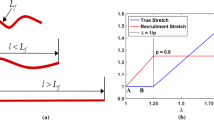Abstract
Many models of the mechanical response of arteries assume a reinforcement with two families of helically wound fibres of collagen of opposite pitch. Motivated by experimental observations, the consequences for the internal pressurisation of arteries of a slight asymmetry in the winding angles is investigated here. It is shown that a torsional shear stress is generated as a result of this flaw, with some common models of the mechanical response of arteries exhibiting significant shear stresses. If the shear stress is significant, then the corresponding model would not seem to be robust, given that an infinitesimal change in a model parameter results in a large change in system response, although it is also shown that there is a ‘magic-angle’ for fibre winding that eliminates torsional shear stress for many of the commonly used models. Finite Element simulations are used to further illustrate the main consequences of fibre asymmetry for some of the more common models of arterial response. If the fibre asymmetry is localised in a region, then simulations show that there is the possibility of significant bending of the artery centred in this region at physiological blood pressure.








Similar content being viewed by others
References
Holzapfel GA, Gasser TC, Ogden RW (2000) A new constitutive framework for arterial wall mechanics and a comparative study of material models. J Elast 6:1–48
Schriefl AJ, Zeindlinger G, Pierce DM, Regitnig P, Holzapfel GA (2012) Determination of the layer-specific distributed collagen fiber orientations in human thoracic and abdominal aortas and common iliac arteries. J R Soc Interface 9:1275–1286
Schriefl AJ, Wolinski H, Regitnig P, Kohlwein SD, Holzapfel GA (2013) An automated approach for three-dimensional quantification of fibrillar structures in optically cleared soft biological tissues. J R Soc Interface 10:20120760
Maceri F, Marino M, Vairo G (2010) A unified multiscale mechanical model for soft collagenous tissues with regular fiber arrangement. J Biomech 43:355–363
Hilborn RC (2000) Chaos and nonlinear dynamics: an introduction for scientists and engineers. Oxford University Press, Oxford
Gasser TC, Ogden RW, Holzapfel GA (2006) Hyperelastic modelling of arterial layers with distributed collagen fibre orientations. J R Soc Interface 3:15–35
Goriely A, Tabor M, (2013) Rotation, inversion and perversion in anisotropic elastic cylindrical tubes and membranes. In: Proceedings of the royal society a: mathematical, physical and engineering science, vol 469
Cortes DH, Lake SP, Kadlowec JA, Soslowsky LJ, Elliott DM (2010) Characterizing the mechanical contribution of fiber angular distribution in connective tissue: comparison of two modeling approaches. Biomech Model Mechanobiol 9:651–658
Pandolfi A, Vasta M (2012) Fiber distributed hyperelastic modeling of biological tissues. Mech Mater 44:151–162
Holzapfel GA, Ogden RW (2015) On the tension? Compression switch in soft fibrous solids. Eur J Mech A Solids 49:561–569
Weiss JN, Garfinkel A, Spano ML, Ditto WL (1994) Chaos and chaos control in biology. J Clin Investig 93:1355–1360
Holzapfel GA (2000) Nonlinear solid mechanics, vol 24. Wiley, Chichester
Luetkemeyer CM, James RH, Devarakonda ST, Le VP, Liu Q, Han HC, Wagenseil JE (2015) Critical buckling pressure in mouse carotid arteries with altered elastic fibers. J Mech Behav Biomed Mater 46:69–82
Han HC (2008) Nonlinear buckling of blood vessels: a theoretical study. J Biomech 41:2708–2713
Datir P, Lee AY, Lamm SD, Han HC (2011) Effects of geometric variations on the buckling of arteries. Int J Appl Mech 3:385–406
Acknowledgements
JGM would like to thank Professor Y. Fu for stimulating discussions on this and other topics. The work of BP is supported by Science Foundation Ireland, project number 12/IP/1732. We are grateful to the reviewers for their insights and helpful comments which have been incorporated into this revised version.
Author information
Authors and Affiliations
Corresponding author
Appendix: Derivation of (15)
Appendix: Derivation of (15)
To the first order in \(\epsilon\), the infinitesimal imbalance in the fibres,
Let the ‘0’ superscript denote evaluation of the appropriate partial derivative at \(\left( I_1,I_2,I_4,I_5,I_6,I_7, I_8\right) = \left( I_1,I_2,I_4,I_5,I_4,I_5, S^2-\frac{r^2}{R^2}C^2 \right)\). Then this truncated Taylor series expansion can be re-written more succinctly in the form
If \(W_k^1 \equiv W_{k6}^0 2SC\left( 1-\frac{r^2}{R^2}\right) +W_{k7}^0 2 SC\left( 1-\frac{r^4}{R^4}\right) + W_{k8}^0SC\left( 1+\frac{r^2}{R^2}\right)\), then (29) can be re-written in the form
which is (15).
Rights and permissions
About this article
Cite this article
Gilchrist, M.D., Murphy, J.G., Pierrat, B. et al. Slight asymmetry in the winding angles of reinforcing collagen can cause large shear stresses in arteries and even induce buckling. Meccanica 52, 3417–3429 (2017). https://doi.org/10.1007/s11012-017-0646-9
Received:
Accepted:
Published:
Issue Date:
DOI: https://doi.org/10.1007/s11012-017-0646-9




